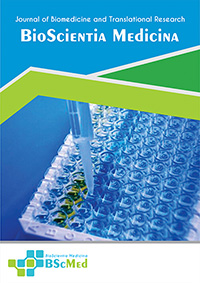Main Article Content
Abstract
Background: Cesarean scar pregnancy (CSP) is a rare form of ectopic pregnancy where the gestational sac implants within the fibrous tissue of a previous cesarean section scar. Its incidence is rising in parallel with increasing cesarean delivery rates, posing significant risks of maternal morbidity, including uterine rupture and severe hemorrhage. Type I CSP, or endogenic CSP, involves implantation on a healed scar with growth primarily towards the uterine cavity. Early and accurate diagnosis, relying heavily on ultrasonographic nuances, is crucial for appropriate management and fertility preservation.
Case presentation: We present the case of a 36-year-old woman, G7P3033, with a history of two prior cesarean sections, who presented at 6-7 weeks of gestation with vaginal discharge. Transabdominal ultrasonography revealed a gestational sac implanted on the anterior uterine wall within the cesarean scar area, with a thin myometrium between the sac and the bladder, consistent with a Type I (endogenic, COS-1, Grade II) Cesarean Scar Pregnancy. The patient also had Stage II hypertension. After thorough evaluation and counseling, the patient underwent a laparotomy with wedge resection of the CSP and scar revision, along with bilateral fimbriectomy as per her request for sterilization.
Conclusion: This case highlights the importance of high clinical suspicion for CSP in pregnant women with previous cesarean sections presenting with early pregnancy symptoms. Detailed ultrasonography is paramount for accurate diagnosis, classification, and guiding management. Surgical management, specifically laparotomy with wedge resection and scar repair, proved to be an effective treatment for this Type I CSP, allowing for removal of the ectopic pregnancy and reinforcement of the uterine wall, while addressing the patient's desire for permanent contraception. Timely intervention is key to preventing life-threatening complications and preserving future reproductive options if desired.
Keywords
Article Details
As our aim is to disseminate original research article, hence the publishing right is a necessary one. The publishing right is needed in order to reach the agreement between the author and publisher. As the journal is fully open access, the authors will sign an exclusive license agreement.
The authors have the right to:
- Share their article in the same ways permitted to third parties under the relevant user license.
- Retain copyright, patent, trademark and other intellectual property rights including research data.
- Proper attribution and credit for the published work.
For the open access article, the publisher is granted to the following right.
- The non-exclusive right to publish the article and grant right to others.
- For the published article, the publisher applied for the Creative Commons Attribution-NonCommercial-ShareAlike 4.0 International License.





